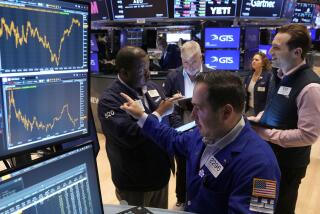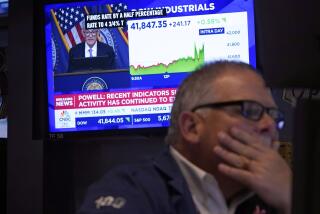Fed surprise fuels stocks and concern
WASHINGTON — Signaling that the recovery is still fragile, the Federal Reserve stunned financial markets and many experts by delaying a pullback in its massive stimulus program and then downgrading its outlook for economic growth.
Citing worries about the looming budget showdown in Washington and the recent boost in long-term interest rates, Fed officials said they would keep buying $85 billion worth of bonds a month in a bid to drive rates back down and give a little more support to the sluggish economy and, especially, the weak job market.
The surprise decision Wednesday sent stocks rocketing within minutes as investors welcomed the continuation of the central bank’s easy-money policies.
The Dow Jones industrial average closed at a record high, and analysts said it was now likely that mortgage rates would drift back down somewhat, boosting a housing market that has lost a little steam lately. The yield on the benchmark 10-year Treasury bond, which closely tracks mortgage rates, fell sharply after the Fed’s announcement.
Yet underlying the Fed’s action was the sobering reality that the economy, after more than four years of recovery, has yet to show sustained vigor and remains fragile, with new threats on the horizon.
Moreover, although the immediate market reaction was one of almost euphoria, analysts fear that the Fed’s willingness to buck widespread anticipation of a stimulus cut would come back to haunt the central bank and its ability to manage expectations in the future.
Chairman Ben S. Bernanke and his colleagues, particularly Vice Chair Janet L. Yellen, had worked hard to make the Fed more transparent and give clearer signals to financial markets. And many analysts and investors had come to believe from recent public statements by Fed officials that it would start dialing back the stimulus this month.
If markets feel “burned” by the decision, as one analyst put it, and starts to cast more doubt on Fed statements — or their reading of them — it could hamper the central bank’s effectiveness.
“We wonder … whether the longer-lasting reaction will be increased volatility in markets as the Fed’s communications become even more confused,” said Paul Ashworth, an economist at Capital Economics.
Bernanke, in a news conference Wednesday after the Fed issued its policy statement and new outlook, responded to this potential problem with an almost defiant tone.
“We can’t let market expectations dictate our policy decisions,” he said. “Our policy actions have to be determined by our best assessment of what’s needed for the economy.”
Bernanke, who declined to speak about his expected departure as chairman in January, said he never stated that the Fed was going to reduce the bond-buying in September.
“As I’ve said, asset purchases are not on a pre-set course, they are conditional on the data, they’ve always been conditional on the data,” he pointed out.
And in the eyes of the Fed, the recent data have not been reassuring.
Despite a marked improvement in the unemployment rate over the last year, Fed policymakers agreed that they weren’t confident enough yet that the economy could handle a reduction in a key stimulus program. So they decided to wait for more evidence.
The Fed, meanwhile, downgraded its forecast for economic growth to 2% to 2.3% this year from its June forecast of 2.3% to 2.6%. And next year, the Fed projects the economy will grow 2.9% to 3.1%, down from its June range of 3% to 3.5%.
The Fed has a dual mandate to control inflation and maximize employment. But it’s the job market that has been the bigger focus for Bernanke and most of his colleagues.
As part of their communications strategy, Fed officials made explicit that they were unlikely to raise near-zero short-term interest rates as long as the unemployment rate was above 6.5%.
Bernanke also indicated previously that the bond-buying stimulus, which targets long-term rates, would end around the time the jobless rate drops to 7%, estimated to be mid-2014. But on Wednesday, Bernanke spoke more vaguely about the significance of this rate as a threshold for action.
“The unemployment rate is not necessarily a great measure in all circumstances of the state of the labor market overall,” Bernanke said. “There is no magic number we are shooting for. We are looking for overall improvement in the labor market.”
The unemployment rate has dropped to 7.3% last month from 8.1% when the stimulus program began a year ago, and Bernanke viewed most of that decline as a result of job growth, not people quitting the labor force because they were discouraged.
Nonetheless, he said the current jobless figure was still “well above acceptable levels.”
In addition, the percentage of Americans in the labor force has continued to fall and real wages have not grown, he said.
Recent tightening in financial markets, such as rising mortgage rates, also was a threat to economic growth, Bernanke said.
Interest rates have risen sharply — with mortgage rates up about 1 percentage point since June — in large part because Bernanke and the Fed indicated they were preparing to reduce monthly bond purchases, which were designed to push down long-term rates.
Asked whether Bernanke himself was responsible for the tightening in markets, the chairman defended himself and the committee, saying that at the time officials began talking about a withdrawal of stimulus, the labor market had made “meaningful progress.”
When the Fed started the bond-buying program, “our goal was to achieve a substantial improvement in the outlook for the labor market [and] we needed to communicate how that was going to be put into practice,” he said.
“Failing to communicate that information would have risked creating a large divergence between market expectations, public expectations and what the committee intentions were,” he said, “and that could have led to much more serious problems down the road.”
Joshua N. Feinman, chief U.S. economist for Deutsche Bank, said Fed officials have a “delicate balancing act” in trying to keep interest rates at the right level.
“When the Fed started mentioning tapering, interest rates were extremely low and the Fed was a little worried that things were getting a little too frothy in financial markets,” he said.
“I think they tried to push back against that. At the same time they’re worried about the pendulum swinging too far in the other direction,” he said. “They don’t want financial conditions to tighten too much because they don’t’ think the economy can handle it.”
The looming fight in Washington over the debt ceiling and next year’s fiscal budget also weighed on Fed officials.
In their policy statement, they noted that fiscal spending cuts had restrained economic growth, and Bernanke said that “a government shutdown, and perhaps even more so a failure to raise the debt limit, could have very serious consequences for the financial markets and for the economy.”
More to Read
Inside the business of entertainment
The Wide Shot brings you news, analysis and insights on everything from streaming wars to production — and what it all means for the future.
You may occasionally receive promotional content from the Los Angeles Times.












